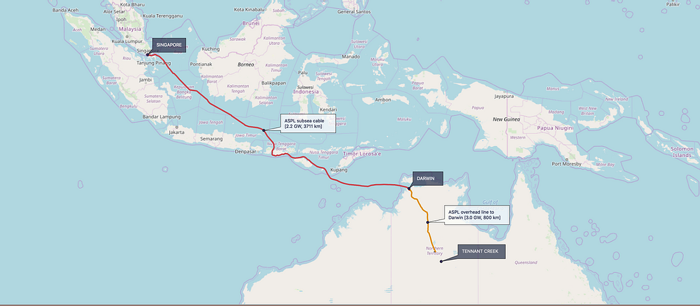It looks like you're new here. If you want to get involved, click one of these buttons!
.....the Power Link doesn't just involve building the world's largest solar farm, which will be easily visible from space. The project also anticipates construction of what will be the world's longest submarine power cable, which will export electricity all the way from outback Australia to Singapore via a 4,500-kilometre (2,800 miles) high-voltage direct current (HVDC) network.

© 2015 Mutual Fund Observer. All rights reserved.
© 2015 Mutual Fund Observer. All rights reserved. Powered by Vanilla
Comments
This shows how far behind the times I am. I had thought (and it used to be true) that AC was better than DC for power transmission. From National Geographic, 2012: https://www.nationalgeographic.com/news/energy/2012/12/121206-high-voltage-dc-breakthrough/
"If you have the transmission of electricity over very large distances between countries, then the flow of energy changes from liquid fuels – oil and LNG – to electrons." (Original article.)
Electrons "flow" only in DC. "The electrons in an AC circuit don’t really move along with the current flow. Instead, they sort of sit and wiggle back and forth." At least the basic laws of physics haven't changed.
https://www.dummies.com/education/science/science-electronics/electronics-basics-direct-and-alternating-current/
Mr. Thomas Edison and friends were attempting to figure how to move "dc" electricity throughout a community for electric lighting. A very costly proposition at the time and not efficient for the use of electrons.
I recall studying the early course material for electronics in the late 1960's. A fairly common question among the students revolved around electron flow in various materials, which is the basis for causing AC or DC current/voltage potentials.
The instructor suggested that one could pursue studies at a PhD level to obtain a better understanding.
I decided at my young age, for my purposes of learning and passing this early class and the more advanced classes to follow, that I would accept the fact that electrons exist and some very brilliant folks had discovered way before my time how to "manipulate" the electrons.
I also recall that several of my large text books contained the common title words of "theory of"; which for me was a "I'll take your word for it" moment. I took the authors at their word and that I needed to concentrate on how to discover (trouble-shoot) why a group of electrons started at point "A" and didn't finish their mission at point "B" or other locations.
Hole flow was interesting for our young minds, as we did not have a prior need for such pondering.
Today, of course; few seldom consider the power of electrons at their fingertips via their phones and personal computers.
To greatly simplify, the effective power that can be delivered through a circuit is the product of the voltage x the amperage (current). So to deliver more power through the same set of transmission lines the voltage can be increased. If a resistive load such as an electric heater needs 1000 watts of power, that can be delivered by supplying 100 volts at 10 amps, or alternatively by 200 volts at 5 amps, etc. The 200 volt supply would be preferable from the standpoint of power transmission, as the power lines need only be 1/2 as thick, saving copper, weight, and therefore expense.
However, as AC voltage is increased to extremely high values, other complex issues come into play, causing significant losses in power transmission. Because of advances in electronic switching apparatus, it is now also possible to transmit extremely high DC voltages.
The voltage generated is still actually AC, and transformers are used to increase that voltage to extremely high values. That high voltage is then converted to DC, and sent over typically long transmission lines. At the receiving end, the DC is reconverted to AC for local distribution. The terminal equipment for the DC lines is expensive, but the transmission lines are much thinner, and the transmission losses are much smaller.
As Davfor's post illustrates, this transmission mode is especially useful for long underwater transmission lines.
If interested, good information on all of this is available at Wickipedia.
The first major HVDC transmission line in the US has been sending renewable hydropower from Bonneville Dam to the Los Angeles area via an 846-mile long overhead line for about 50 years.
https://new.abb.com/news/detail/45972/abb-completes-upgrade-of-first-major-hvdc-link-in-us-transmission-history
BofA on Green Hydrogen
Wikipedia description
I must admit, I always thought of solar as a "local" power solution. If this is a feasible option, it seems like a real game changer. Imagine a continent like Africa, with all it's economic hurdles, becoming a vast exporter of energy to far-flung locations.